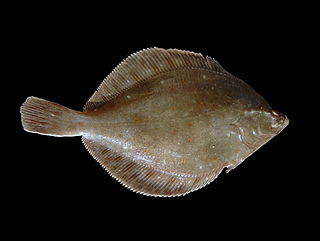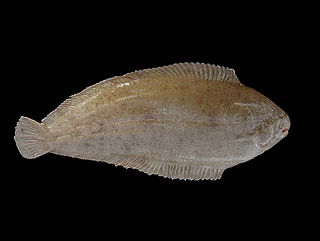
A flatfish is a member of the ray-finned demersal fish order Pleuronectiformes, also called the Heterosomata, sometimes classified as a suborder of Perciformes. In many species, both eyes lie on one side of the head, one or the other migrating through or around the head during development. Some species face their left sides upward, some face their right sides upward, and others face either side upward.
Lophopyxis is a genus of flowering plants and the sole genus of the family Lophopyxidaceae. The group consists of two species of tendrillate lianas. They are found in the Sunda Islands.

Pleuronectidae, also known as righteye flounders, are a family of flounders. They are called "righteye flounders" because most species lie on the sea bottom on their left sides, with both eyes on their right sides. The Paralichthyidae are the opposite, with their eyes on the left side. A small number of species in Pleuronectidae can also have their eyes on the left side, notably the members of the genus Platichthys.

Dirachma is the sole genus of the family Dirachmaceae. The genus had been monotypic, its sole species being the woody plant Dirachma socotrana, until a second, herbaceous, species, Dirachma somalensis, was discovered in Somalia and described in 1991.

Goupia is a neotropical genus of flowering plants and the sole genus included in the family Goupiaceae. There are three species, all found in tropical northern South America.

Phyllonoma is a genus consisting of 4 species of trees and shrubs. Phyllonoma is the sole genus in the family Phyllonomaceae. Phyllonoma species are native to South and Central America.
Scolomys is a genus of rodent in the tribe Oryzomyini of the family Cricetidae. Some evidence suggests that it is related to Zygodontomys. It is characterized, among other traits, by spiny fur. It contains two species, S. melanops and S. ucayalensis.

True's shrew mole is a species of mammal in the family Talpidae. It is endemic to Japan and is a common species above 1000 meters in grassland, shrubland and forest. Sometimes this species is called the lesser Japanese shrew mole and another species, Urotrichus talpoides, is called the "greater Japanese shrew mole".

Chlorokybus is a multicellular (sarcinoid) genus of basal green algae or charophyte. It has been classified as the sole member of the family Chlorokybaceae, which is the sole member of the order Chlorokybales, in turn the sole member of the class Chlorokybophyceae. It grows on soil and rock surfaces, and is rare.

Cyphokentia is a genus of flowering plant in the palm family endemic to New Caledonia. the genus is named from two Greek words meaning "tumor" and "Kentia", a former palm genus, and the species name translates to "large" and "spike", describing the inflorescence. The genus has two known species and Its closest relative is Clinosperma, also endemic to New Caledonia, and the sole other genus of the subtribe Clinospermatinae.

Koeberlinia is a genus of flowering plant. It is the sole genus in the family Koeberliniaceae. Alternately it is treated as a member of the Capparaceae.

Fouquieria is a genus of 11 species of desert flowering plants, the sole genus in the family Fouquieriaceae. The genus is native to North America and includes the ocotillo and the Boojum tree or cirio. They have semi succulent stems with thinner spikes projecting from them, with leaves on the bases spikes. They are unrelated to cacti and do not look much like them; their stems are proportionately thinner than cactus stems and their leaves are larger.
Erythrobatrachus is an extinct genus of trematosaurian temnospondyl within the family Trematosauridae. The sole species Erythrobatrachus noonkanbahensis was separated to a monotypic genus, distinguishing it from related taxa when the description was published in 1972. The type material was a matrix cast revealing the impression of several fragments of skull excavated at the Blina Shale formation in the northwest of the Australian continent. The genus name is derived from ancient Greek, combining terms for red, erythro, with frog, batrachos, to describe the iron staining of the fossilised amphibian specimens. The type location described by the specific epithet was Noonkanbah Station.
Ixorheis is a genus of parasitic alveolates in the phylum Apicomplexa.

Solea is a genus of soles from the Indo-Pacific and East Atlantic Oceans, and the Mediterranean Sea.

Plocosperma is the sole genus in the Plocospermataceae, a family of flowering plants. The genus contains a single species, Plocosperma buxifolium.
Phaeosaccion is a genus of algae with monostromatic tubular to saccate thalli, up to 20 centimetres (7.9 in) long and to 2 centimetres (0.79 in) wide. It is the sole genus in the family Phaeosaccionaceae. It is olive brown and resembles young plants of Scytosiphon. The sole species in the genus is Phaeosaccion collinsii, a species of marine algae. It was first identified in a publication by W.G. Farlow in the article Notes on New England algae published in Bulletin of the Torrey Botanical Club in 1882. It was named in honor of Frank Shipley Collins. Phaeosacchion collinsii is red listed in Iceland as a vulnerable species (VU).
Bossavirus is a genus of viruses in the subfamily Gammaherpesvirinae, in the family Herpesviridae, in the order Herpesvirales. It contains the sole species Delphinid gammaherpesvirus 1.
Patagivirus is a genus of viruses in the subfamily Gammaherpesvirinae, in the family Herpesviridae, in the order Herpesvirales. It contains the sole species Vespertilionid gammaherpesvirus 3.











